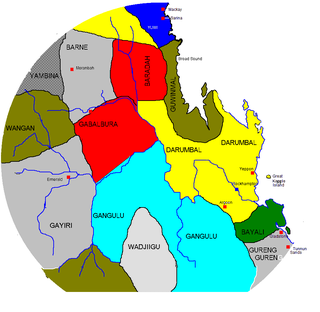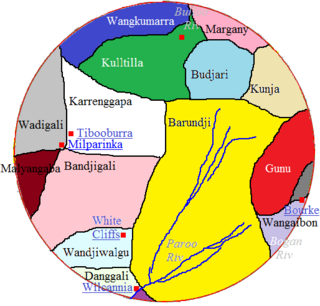Related Research Articles
The Bakanambia, also known as the Wanbara, are an Aboriginal group of Australia. Traditionally, the Bakanambia lived in the vicinity of Princess Charlotte Bay in the state of Queensland. One of the ethnonyms applied to them was Lama Lama, which is now used of a larger aggregation of remnants of several tribes.

The Wonnarua people, otherwise written Wanarruwa, are a group of Aboriginal Australian people united by strong ties of kinship, and who survived in family groups or clans scattered along the inland area of what is now known as the Upper Hunter Valley, New South Wales, Australia. Their creation spirit is Baiami, also known as Koin, the creator of all things and the Keeper of the Valley.
Yugambal, or Yugumbil (Jukambil), is an Australian Aboriginal language of northern New South Wales.
The Ngarabal are an Aboriginal people of the area from Ashford, Tenterfield and Glen Innes in northern New South Wales, Australia.

The Gangulu people, also written Kangulu, Kaangooloo, Ghungalu and other variations, are an Aboriginal Australian people from the Mount Morgan area in Queensland, Australia.

The Ngarigo people are Aboriginal Australian people of southeast New South Wales, whose traditional lands also extend around the present border with Victoria. They are named for their language, Ngarigo, which in the 19th century was said to be spoken by the Nyamudy people.
The Ngintait, or Ngindadj, are an Australian Aboriginal peoples of the northwest corner of the state of Victoria, and partly in South Australia. 9 people, all of one family, claim descent from the tribe, which was dispersed in the 19th century.
The Gia people, also known as Giya, Kia, Bumbarra, and variants, are an Aboriginal Australian people of the state of Queensland. Little is known of them.
The Wotjobaluk are an Aboriginal Australian people of the state of Victoria. They are closely related to the Wergaia people.
The Kuungkari are an indigenous Australian people of Queensland. They are to be distinguished from the Kunggari.
The Kwiambal are an Aboriginal Australian people of New South Wales.

The Karenggapa are an Aboriginal Australian people of New South Wales.
The Wanggumara, also spelt Wangkumara, Wongkumara, Wangkumarra, and other variants, are an Aboriginal people of the state of Queensland, Australia.
The Bidjara people, also spelt Bitjara or Bithara, are an Aboriginal Australian people of south-western Queensland. They spoke a dialect of the Ngura language. They are not to be confused with the Warrego River Pitjara or the Badjiri of the Paroo River, both of whose traditional lands are further to the east of the state.
The Warrgamay people, also spelt Warakamai, are an Aboriginal Australian people of the state of Queensland.
The Kunggara, also known as Kuritjara, are an indigenous Australian people of the southern Cape York Peninsula in Queensland.
The Arakwal are an Aboriginal Australian people of the state of New South Wales.
The Gawambaraay (Kawambarai) are an Aboriginal Australian people of the state of New South Wales, closely connected to the Gamilaraay (Kamilaroi) people. Their traditional lands are in the central–western district of New South Wales
The Wanjiwalku were an indigenous Australian people of the state of New South Wales.
The Yaran language, also called Bindjali, is an extinct language spoken around the Padthaway district by the Bodaruwitj. William Haynes, an earlier resident of the area, provided E.M.Curr with two distinct vocabularies of the area, which he designated as that of the Tatiara. Norman Tindale compiled a word-list relying on information supplied to him by Milerum, whose mother Lakwunami was a Potaruwutj from the Keilira region. R.M: Dixon managed to elicit a vocabulary of Bindjali from a Bordertown informant, Bertie Pinkie, as late as 1973. In his classification, Polinjunga, one of the alternative names for the Bodaruwitj, or a clan name of the same, is listed as a dialect of the Bungandidj-Kuurn Kopan Noot subgroup of the Kulinic languages.
References
- ↑ E91 Marbal at the Australian Indigenous Languages Database, Australian Institute of Aboriginal and Torres Strait Islander Studies
- ↑ Macpherson, J. (1905). Ngarrabul and other Aboriginal Tribes. Proceedings of the Linnean Society of New South Wales, 29, 677 - 684
- ↑ Tindale, NB (1974). Aboriginal tribes of Australia : their terrain, environmental controls, distribution, limits, and proper names. Berkeley: University of California Press
- ↑ Curr, Edward M. 1886-1887. The Australian race: its origin, languages, customs, place of landing in Australia, and the routes by which it spread itself over that continent, Melbourne, John Ferres, Government Printer, Vol. 3, p. 78
- ↑ Dixon, RMW (1976). Grammatical Categories in Australian Languages. Australian Institute of Aboriginal Studies: Canberra
- ↑ Wafer, J.W., Wafer, J., Lissarrague, A., Harkins, J. (2008). A Handbook of Aboriginal Languages of New South Wales and the Australian Capital Territory. Muurrbay Aboriginal Language and Culture Co-operative